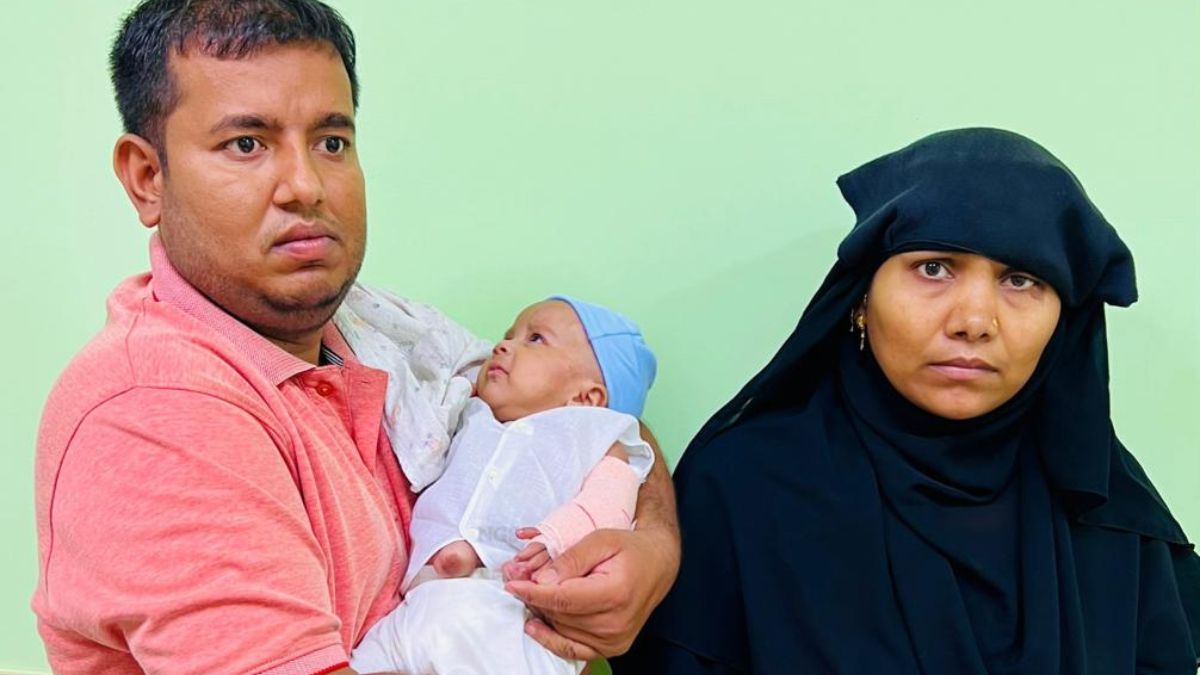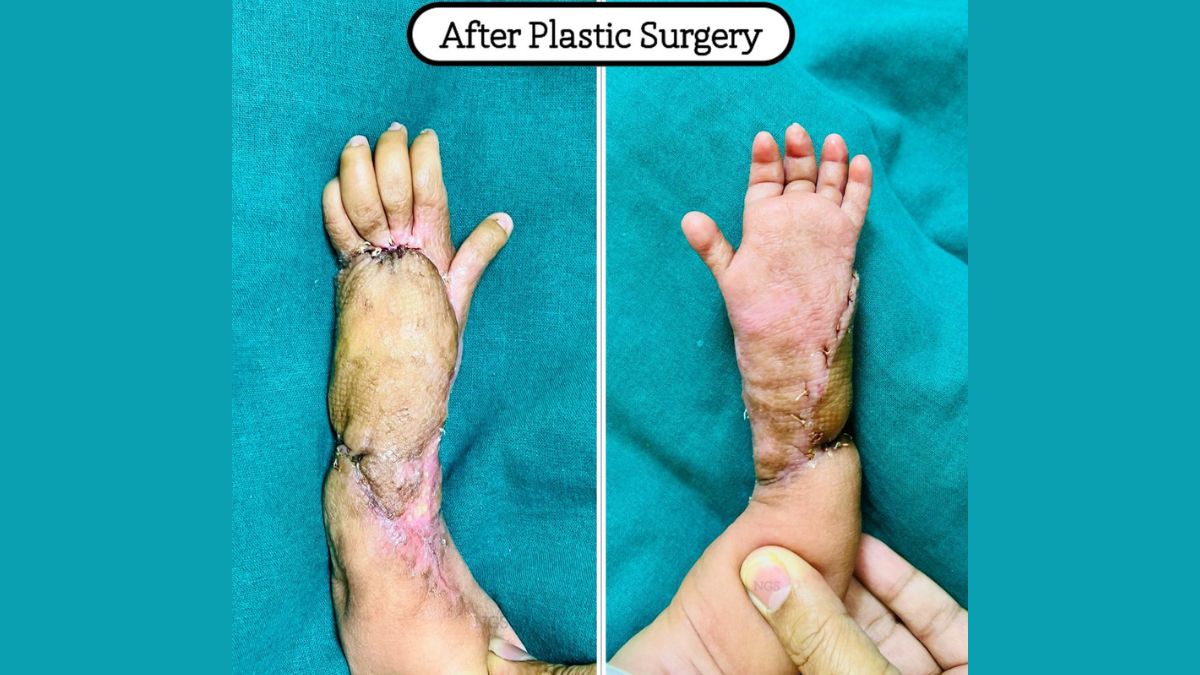
In a remarkable medical story that highlights the power of modern healthcare, doctors managed to save the forearms of a two month old girl from amputation following a serious bout of gangrene. In a race against time, the girl’s arms were rapidly deteriorating due to catching a severe infection shortly after birth. This narrative reflects the strides made in medicine and the hope it brings to families facing such challenges.
Table of Content:-
The girl child had developed severe cellulitis and infection, right after being born, which had caused necrosis of her entire forearm skin. She was treated at the Bai Jerbai Wadia Hospital for Children, where the complex multi-staged surgery took place.
Explaining the case, Dr Nilesh Satbhai, Consultant Plastic, Hand and Reconstructive Microsurgeon, Bai Jerbai Wadia Hospital for Children and Abdul Awwal, the patient’s father, spoke to the team of OnlyMyHealth.
A Harrowing Journey: From Tragedy to Hope
Awwal hails from the Uttar Pradesh border while his wife is from Nepal. His wife had a bad obstetric history. She had lost 4 children out of the 6 pregnancies she had borne in the past. This time around, the couple happily welcomed a baby girl. The baby was born in Nepal after Abdul's wife visited her maternal home for delivery.
However, as tragedy struck again, the newborn had to be admitted to the Intensive Care Unit (ICU) in Nepal, because she was diagnosed with severe cellulitis. “The exact cause of theinfection was not known as the history was unclear,” said Dr Satbhai.

What Is Severe Cellulitis?
According to the Centres for Disease Control and Prevention, severe cellulitis refers to a serious bacterial infection that affects the deeper layers of the skin and underlying tissues. It often presents as a red, swollen area that is warm to the touch and may be accompanied by pain or tenderness.
“The main culprits behind cellulitis are Staphylococcus and Streptococcus bacteria. Treatment involves antibiotics and is usually effective. However, in some cases, cellulitis can deteriorate rapidly if left untreated or unresponsive to antibiotics. This escalation could result in a critical medical situation and potentially a life-threatening outcome,” explained Dr Satbai.
United Kingdom’s National Health Service informed that severe cases of cellulitis can lead to complications such as necrosis (tissue death), abscess formation, or the spread of infection to the bloodstream (sepsis).
“In the child’s case, the cellulitis led to a flesh-eating disease, necrotising fasciitis, which is an infection in the deepest layer of skin spreading to the connective tissue that surrounds your muscles and organs.” The majority of the skin on her left forearm turned black and the child’s condition started to deteriorate rapidly. At this point, Awwal decided to shift his daughter to a well known hospital in Kathmandu.
Also Read: Why Is It Necessary To Get Your Premature Infant Checked For Retinopathy Of Prematurity?

The Road to Recovery
The hospital recommended that they amputate the child’s left upper limb. The parents were not willing to do this, and decided to search for a better solution. Three weeks after their daughter’s birth, the couple brought them to Mumbai for treatment. Awwal said, “It was a harrowing experience, watching our little one face such a daunting challenge at such a tender age. We had lost all our hopes, when we were advised for amputation. “
The child was just 1 month old at this time. Expanding on the patient’s treatment and recovery, Dr Satbhai said, “The child was admitted to the paediatric intensive care unit (PICU) for resuscitation, immediately after she arrived to the hospital. We decided to salvage the limb, for which we had to act quickly.”
Once the infant’s medical condition was permissible, Dr Satbhai and his team carried out the arm reconstruction in multiple stages:
- After the first stage of wound debridement, multiple wound washes were performed.
- The wound was then covered with a large abdominal flap which covered the majority of the wound over the forearm.
- The flap was maintained in position for 3 weeks.
- The flap division was performed in 2 stages.
- The final flap in setting was done after ensuring that the entire wound was covered on both sides of the forearm.
Also Read: Hearing Loss In Infants: Here’s Everything You Need To Know About The Need Of Early Diagnosis
All these surgeries were done within 5 weeks, shared Dr Satbhai, concluding that “The child is stable and achieving normal developmental milestones. Her hand is salvaged due to timely surgical intervention and wound cover. Secondary reconstructive procedures will be needed for further function as the child grows up. Not treating her at the right time could have led to amputation and lifelong disability.”
“Our baby's delicate forearm was spared from the looming threat of amputation. We are extremely happy. We are planning to name our child ‘Tamannah’,” said Awwal.
Tamannah’s remarkable medical journey serves as both a beacon of hope and a cautionary tale. While we celebrate the success of saving the infant's arms from the brink of amputation, we are also reminded of the seriousness of post-birth infections. It underscores the importance of timely medical intervention and the invaluable role of healthcare professionals in transforming dire situations into stories of triumph and healing. Let this narrative inspire you to remain vigilant about early detection and prompt treatment, ensuring that each individual receives the best possible chance for a healthy and fulfilling life.
Also watch this video
How we keep this article up to date:
We work with experts and keep a close eye on the latest in health and wellness. Whenever there is a new research or helpful information, we update our articles with accurate and useful advice.
Current Version